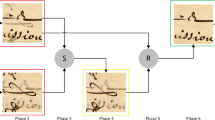Abstract
In the information age, a large volume of Tibetan document images in woodcut edition have been produced. Geometric correction for Tibetan images is the basis of document analysis and character recognition, to which the traditional methods cannot be easily applied because of the complexity and variability of page deformation. To solve the above difficulties, we propose a new geometric correction method that is different from the existing methods. Firstly, we give a generic definition of piecewise strategy for image geometric correction by taking into full consideration the difficulty of seamless joint between sub-images. Then, we provide an effective geometric correction solution for Tibetan document images in woodcut edition, and theoretically prove the condition of seamless splicing between sub-images. According to this condition, appropriate reference points are selected to partition a Tibetan document image into several sub-images, then these sub-images are corrected by projective transformation, and finally the corrected sub-images are spliced to compose a corrected Tibetan document image. Experiments were conducted on real Tibetan woodcut document images by comparing the proposed method with classical algorithms including the FFT (Fast Fourier Transformation) method, the Hough method, the projection profile method and the cross correlation method. The visualized observation results and the statistical results proved that the proposed method can obtain a better correction performance, and took less than half the time of the comparison methods.












Similar content being viewed by others
Change history
07 April 2022
A Correction to this paper has been published: https://doi.org/10.1007/s11042-022-12970-5
References
Ai S, Wang X, Ma M, Wang K (2013) A method for correcting non-linear geometric deformation in ultra-wide-angle imaging system. Optik 124 (24):7014–7021
Boudraa O, Hidouci WK, Michelucci D (2020) Using skeleton and Hough transform variant to correct skew in historical documents. Math Comput Simul 167:389–403
Haneishi H, Yagihashi Y, Miyake Y (1995) A new method for distortion correction of electronic endoscope images. IEEE Trans Med Imaging 14 (3):548–555
Huang H, Da F (2014) Sparse representation-based classification algorithm for optical Tibetan character recognition. Optik 125(3):1034–1037
Jain B, Borah M (2014) A comparison paper on skew detection of scanned document images based on horizontal and vertical projection profile analysis. Int J Sci Res Publ 4(6):1–4
Jan M (2013) Straighten image. http://cn.mathworks.com/matlabcentral/fileexchange/40239-straighten-image. Accessed Apr 27 2019
Jiang X, Bunke H, Widmer-Kljajo D (1999) Skew detection of document Images by focused nearest-neighbor clustering. In: Proceedings of 5th international conference on document analysis and recognition, pp 629–632
Jundale TA, Hegadi RS (2015) Skew detection and correction of Devanagari script using Hough transform. Procedia Comput Sci 45:305–311
Kaur M, Jindal S (2013) An integrated skew detection and correction using fast Fourier transform and DCT. Int J Sci Technol Res 2(12):164–169
Lu Y, Tan CL (2003) Improved nearest neighbor based approach to accurate document skew estimation. In: Proceedings of 7th international conference on document analysis and recognition, pp 503–507
Mohammed SW, Soora NR (2018) Global skew detection and correction using morphological and statistical methods. Computat Vis Bio Inspired Comput 28:556–568
Ngodrup, Zhao DC (2010) Research on wooden blocked Tibetan character segmentation based on drop penetration algorithm. In: Proceedings of Chinese conference on pattern recognition, pp 84–88
Pstl W (1986) Detection of linear oblique structures and skew scan in digitized documents. In: Proceedings of 8th international conference on pattern recognition, pp 487–489
Ramanan M (2019) A hybrid approach for skew detection and correction in the multi-script scanned document. Asian J Res Comput Sci 4(2):1–8
Shemiakina J, Zhukovsky A, Faradjev I (2017) The calculation of a projective transform in the problem of planar object targeting by feature points. In: Proceedings of 9th international conference on machine vision, 10341: 103411N
Shi JB (2006) Study on the earliest Tibetan woodcut literature. In: Proceedings of symposium on the history of printing in China, pp 73–77
Subrahmanyam MSLB, Kumar VV, Reddy BE (2018) A new algorithm for skew detection of Telugu language document based on principle-axis farthest pairs quadrilateral (PFPQ). Int J Image Graph Signal Process 10(3):47–58
Vinod HC, Niranjan SK (2018) Multi-level skew correction approach for hand written Kannada documents. In: Proceedings of international conference on information theoretic security, pp 376–386
Yan H (1993) Skew correction of document images using interline cross-correlation. CVGIP: Graph Models Image Process 55(6):538–543
Yixi LM, Ying Z (2017) A preliminary study of the binding form of the ancient Tibetan literature. Minzu Minsu Wenhua 5:77–82
Zohrevand A, Sadri J, Imani Z, Yeganezad MR (2019) Line segmentation in Persian handwritten documents based on a novel projection histogram method. In: Proceedings of 4th international conference on pattern recognition and image analysis, pp 70–74
Acknowledgements
This work was partially supported by the National Social Science Fund of China under grant 16BTQ037 and the Fundamental Research Funds for the Central Universities under grant 2020NQN23.
Author information
Authors and Affiliations
Corresponding author
Additional information
Publisher’s note
Springer Nature remains neutral with regard to jurisdictional claims in published maps and institutional affiliations.
The original online version of this article was revised: The Acknowledgment was incorrect.
Rights and permissions
About this article
Cite this article
Hu, J., Xiawu, L., Qiao, S. et al. Geometric correction method for Tibetan woodcut document images. Multimed Tools Appl 81, 15609–15632 (2022). https://doi.org/10.1007/s11042-022-12338-9
Received:
Revised:
Accepted:
Published:
Issue Date:
DOI: https://doi.org/10.1007/s11042-022-12338-9




